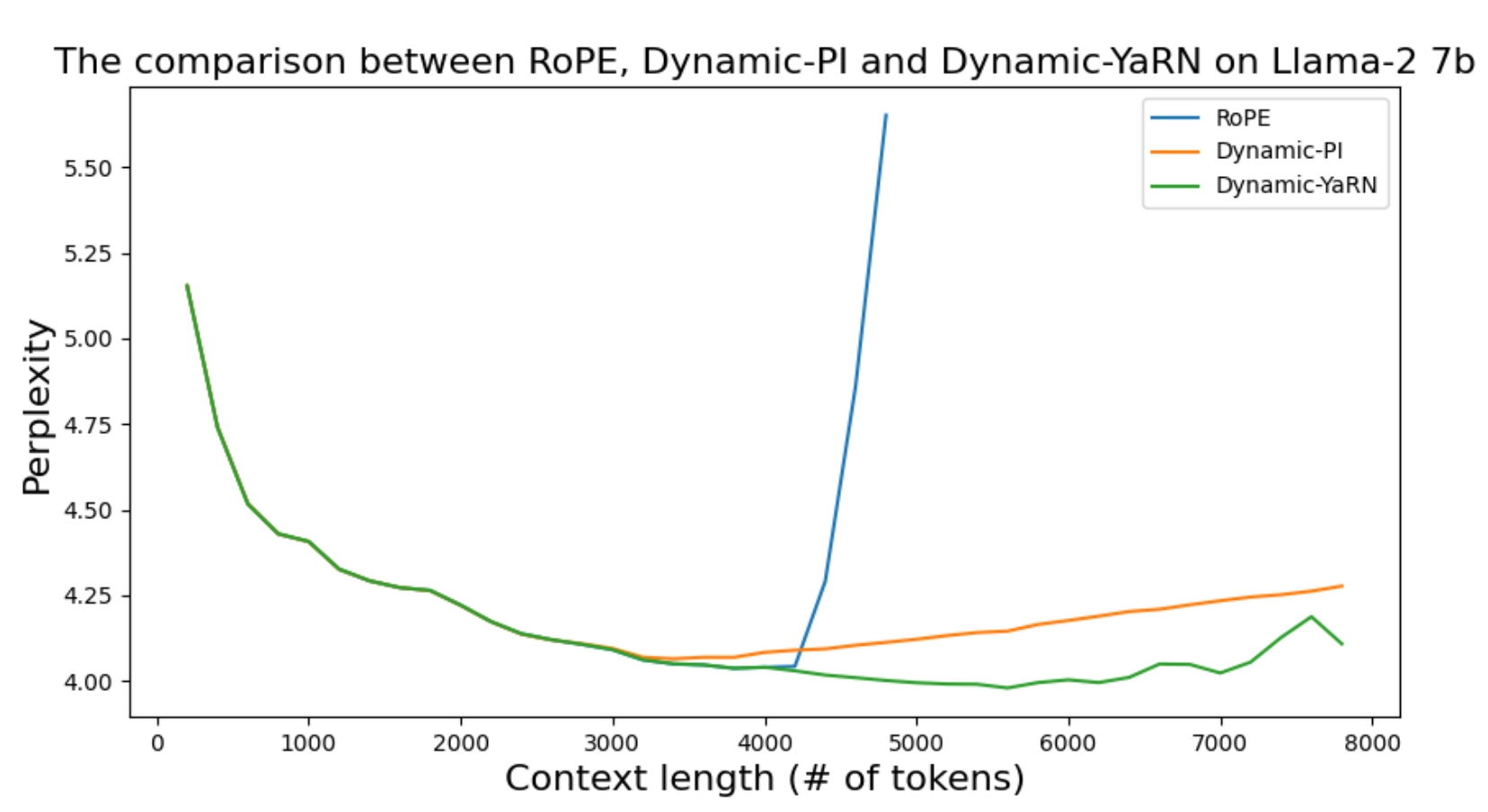# 前言
旋转位置编码(RoPE)目前已被广泛应用于主流大模型中,但是其存在外推性差的缺点,即在模型遇到输入长度超过训练长度时,模型性能会急剧下降。为了解决这个问题,出现了多个方法,如线性插值、NTK-Aware插值、NTK-by-parts、Dynamic NTK、YaRN。
关于RoPE原理,参考这篇文章:RoPE。
# 直接外推
在介绍大模型长度扩展方法之前,需要先说明一下直接外推为什么走不通。
在position interpolation (opens new window)的论文里提到,如果使用长文本从头训练模型,需要大量资源,不太现实。如果直接在预训练的模型上使用长文本微调,经过实验发现,微调超过10000个batches,有效长度从2048到256,效率较低。
现阶段已经存在一些技术可以使模型具有弱外推性,如RoPE。如果在RoPE上直接外推,扩展到模型之前没见过的文本长度,模型的困惑度会飙升到非常高的值(超过1000,正常是个位数)。
# 大模型长度扩展方法
以下将介绍几个主要的扩展方法。
# Position Interpolation
上面提到了直接外推的缺点,后续position interpolation (opens new window)论文提出了位置插值方法。
我们定义函数为RoPE的方法,加入了位置插值的新方法为,令为嵌入向量,为位置下标。
其中表示原本的文本长度,表示更长的文本长度。它的意思是将更大的窗口范围从缩小到使其适应原始的窗口范围,每个位置的旋转弧度也相应缩小了。因为旋转弧度使线性变化的,所以也被称为线性插值。
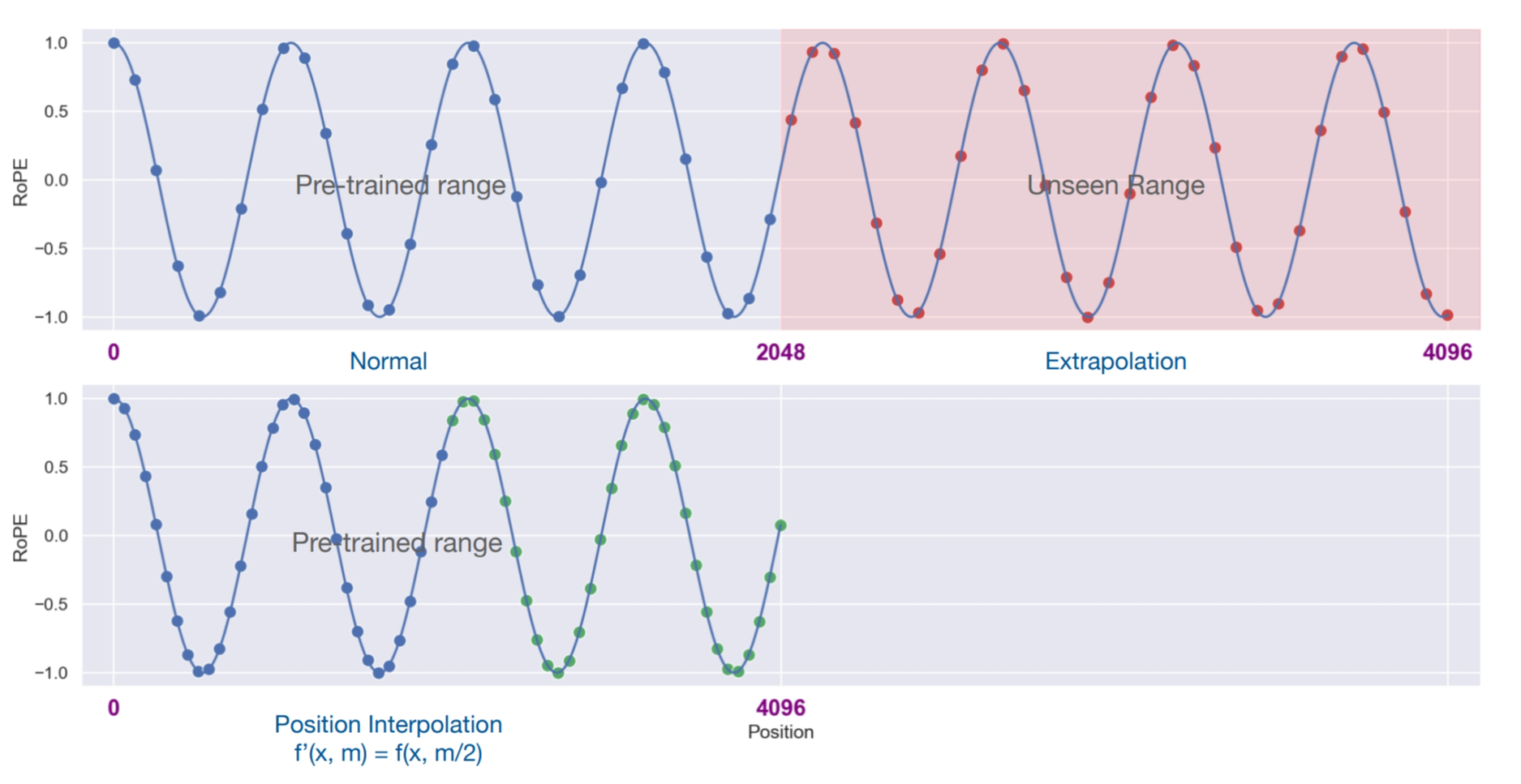
# NTK-Aware Interpolation
在PI出来后不久,有网友在reddit (opens new window)上发表了NTK-Aware插值方法。
作者表示无需微调即可扩展到8K+,同时使困惑度更低。作者受NTK启发,发现只使用位置插值,模型会更难识别接近的token的顺序和位置。因为在相同的区间内,被塞入了更多的token。
所以,作者设计了非线性方法,改变了RoPE中的base。
其中表示缩放因子,可以发现当位置为0时,公式会退化到原始的RoPE公式。随着位置从近到远,缩放因子逐渐变小,旋转弧度的变小速度变大。也就是说,前面的位置靠外推,后面的位置靠位置插值。
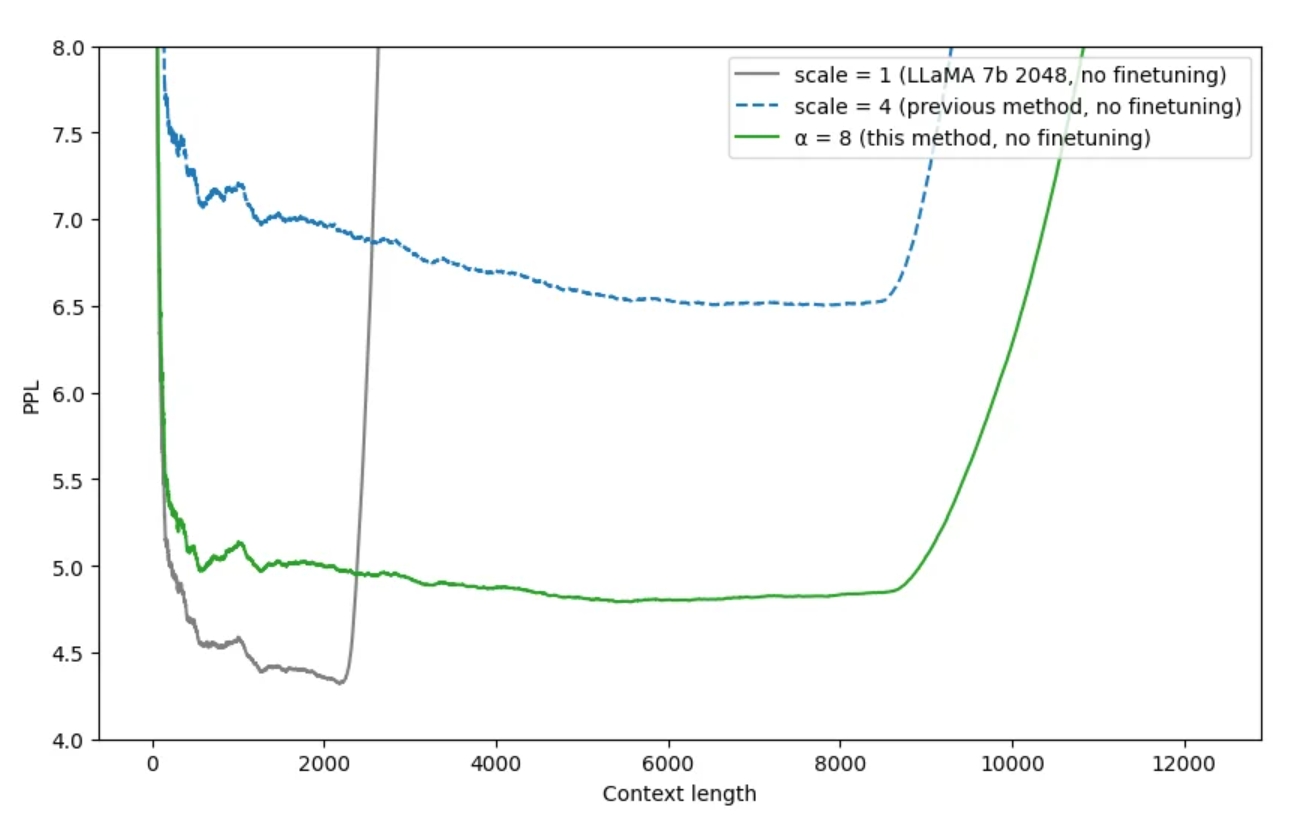
# NTK-by-parts Interpolation
在NTK-Aware Interpolation发布后一个月,作者又发表了优化版本NTK-by-parts Interpolation (opens new window),困惑度再次降低。作者首先删除了缩放因子,原因是这个超参数的值在不同大语言模型下不统一。新算法综合了位置插值、NTK-Aware插值和直接外推,分段采用不同的算法,这也是"by-parts"的含义。简单来说,在位置的前半段使用外推,后半段使用插值。前半段使用外推的原因是之前的算法使用插值导致性能有所下降。
接下来分析一下源码。
#Interpolation constants found experimentally for LLaMA (might not be totally optimal though)
#Do not change unless there is a good reason for doing so!
beta_0 = 1.25
beta_1 = 0.75
gamma_0 = 16
gamma_1 = 2
新算法引入了4个新的超参数,含义分别是两组周期个数的边界值。三角函数的周期是,在窗口长度为的条件下的周期个数是。周期个数越大,表示位置越靠前,反之越靠后。所以代码中的gamma可以理解为表示前半段,beta表示后半段。因为频率越高,周期个数越大。
#Three RoPE extrapolation/interpolation methods
inv_freq_base = 1.0 / (base ** (torch.arange(0, dim, 2).float().to(device) / dim))
inv_freq_linear = 1.0 / (scale * (base ** (torch.arange(0, dim, 2).float().to(device) / dim)))
inv_freq_ntk = 1.0 / (find_newbase_ntk(dim, base, scale) ** (torch.arange(0, dim, 2).float().to(device) / dim))
定义了3个频率,分别是原始的RePE,线性插值和ntk-aware插值,接下来会用到。
def find_correction_factor(num_rotations, dim, base=10000, max_position_embeddings=2048):
"""反向求解位置下标"""
return (dim * math.log(max_position_embeddings/(num_rotations * 2 * math.pi)))/(2 * math.log(base)) #Inverse dim formula to find number of rotations
def find_correction_range(low_rot, high_rot, dim, base=10000, max_position_embeddings=2048):
"""计算区间边界下标"""
low = math.floor(find_correction_factor(low_rot, dim, base, max_position_embeddings))
high = math.ceil(find_correction_factor(high_rot, dim, base, max_position_embeddings))
return max(low, 0), min(high, dim-1) #Clamp values just in case
def linear_ramp_mask(min, max, dim):
"""频率系数归一化"""
if min == max:
max += 0.001 #Prevent singularity
linear_func = (torch.arange(dim, dtype=torch.float32) - min) / (max - min)
ramp_func = torch.clamp(linear_func, 0, 1)
return ramp_func
#Combine NTK and Linear
low, high = find_correction_range(beta_0, beta_1, dim, base, original_max_position_embeddings)
inv_freq_mask = (1 - linear_ramp_mask(low, high, dim // 2).type(current_dtype).to(current_device)) * ntk_factor
inv_freq = inv_freq_linear * (1 - inv_freq_mask) + inv_freq_ntk * inv_freq_mask
这段代码计算了后半段位置的频率,find_correction_range返回了这段位置的边界下标,inv_freq_mask表示屏蔽系数经过归一化,最后的频率通过结合线性插值和ntk插值得出。
位置下标的公式推导:
#Combine Extrapolation and NTK and Linear
low, high = find_correction_range(gamma_0, gamma_1, dim, base, original_max_position_embeddings)
inv_freq_mask = (1 - linear_ramp_mask(low, high, dim // 2).type(current_dtype).to(current_device)) * extrapolation_factor
inv_freq = inv_freq * (1 - inv_freq_mask) + inv_freq_base * inv_freq_mask
这段代码计算了前半段位置的频率,最后的频率通过结合上一段代码的频率和直接外推得出。
由上面代码可以得出,位置从近到远,依次使用外推(保持不变),ntk插值和线性插值。
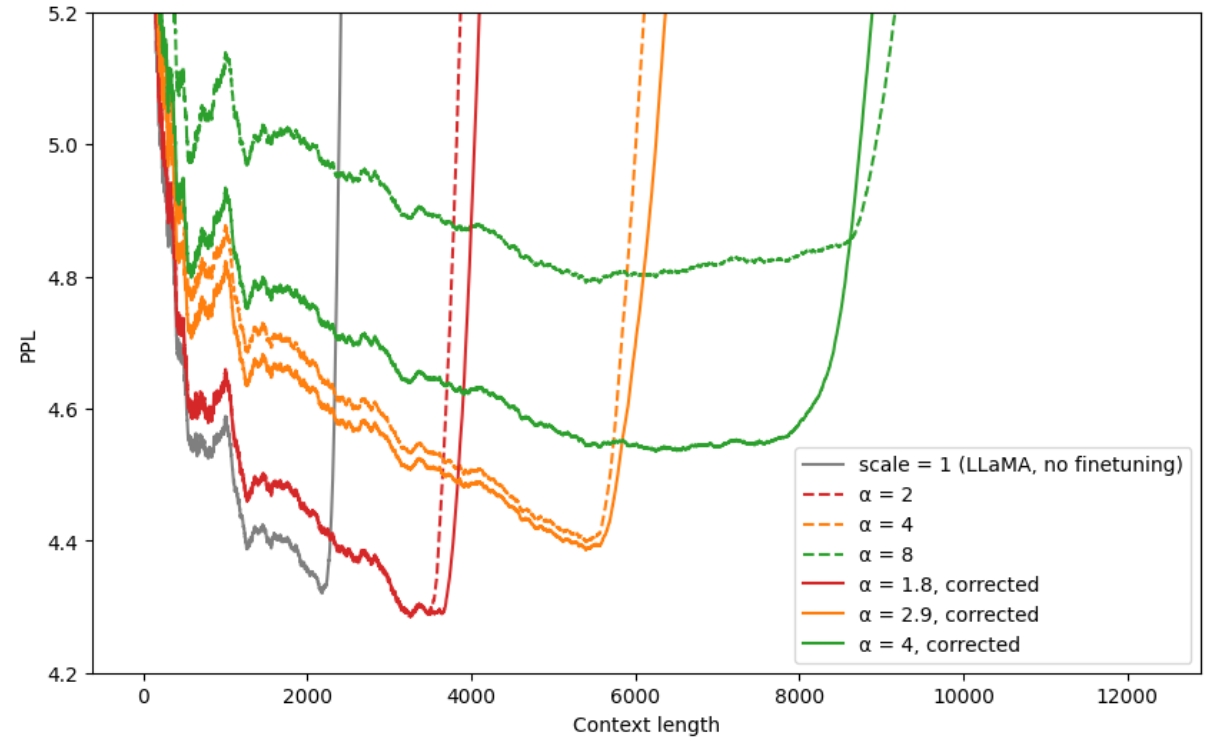
# Dynamic NTK Interpolation
同样是reddit的网友,受NTK-Aware启发,发表了Dynamic NTK Interpolation (opens new window)。作者表示线性插值和NTK插值都存在同样的问题,在训练长度内的表现都不如原始方法,而且NTK的方法存在写死的超参数,有没有办法使动态生成?作者提出如果推理长度在训练长度内不做插值,超过训练长度则每一步使用NTK插值动态放大base,并引入了新的超参数。
令为当前文本长度,为训练最大长度,每生成一个token,都会加1。
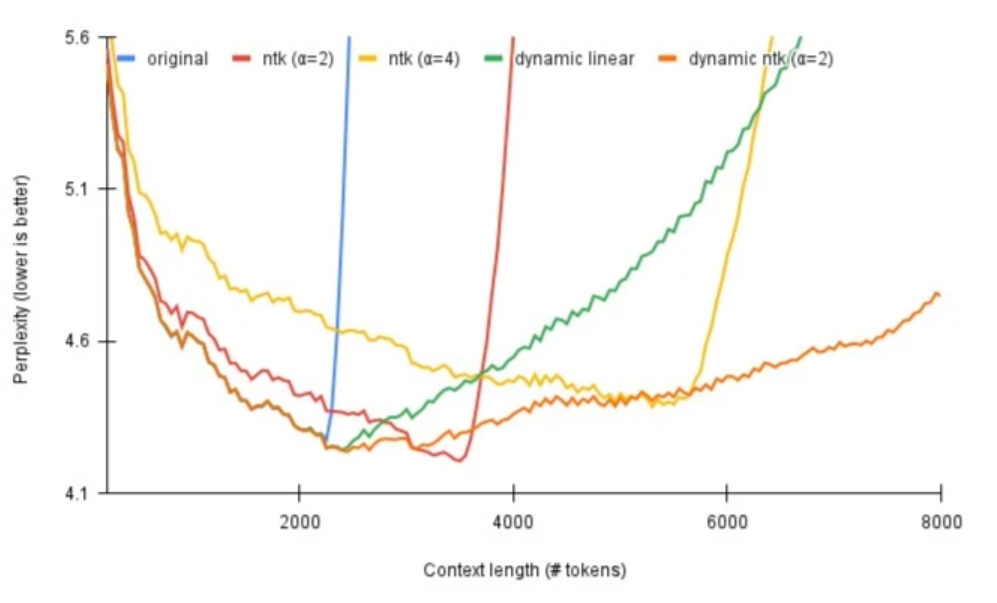
# YaRN
NTK-Aware插值的后继者YaRN (opens new window)。YaRN是Yet another RoPE extensioN method的缩写。论文中详细讲述了线性插值、NTK-Aware插值、NTK-by-parts插值和Dynamic NTK插值的背景、起源和理由,非常值得一读。最后提出结合NTK-by-parts和温度系数t,得到了YaRN。
YaRN修改了注意力计算公式:
关于温度系数t,其中是NTK的缩放因子,是当前长度,L是训练最大长度:
def get_mscale(scale=1):
if scale <= 1:
return 1.0
return 0.1 * math.log(scale) + 1.0
def forward(self, x, seq_len=None):
# x: [bs, num_attention_heads, seq_len, head_size]
# This `if` block is unlikely to be run after we build sin/cos in `__init__`. Keep the logic here just in case.
if seq_len > self.max_seq_len_cached:
self.max_seq_len_cached = seq_len
self.yarn(seq_len / self.original_max_position_embeddings, x.device)
t = torch.arange(self.max_seq_len_cached, device=x.device, dtype=self.inv_freq.dtype)
freqs = torch.einsum("i,j->ij", t, self.inv_freq)
# Different from paper, but it uses a different permutation in order to obtain the same calculation
emb = torch.cat((freqs, freqs), dim=-1).to(x.device)
self.register_buffer("cos_cached", (emb.cos() * self.mscale)[None, None, :, :].to(x.dtype), persistent=False)
self.register_buffer("sin_cached", (emb.sin() * self.mscale)[None, None, :, :].to(x.dtype), persistent=False)
return (
self.cos_cached[:, :, :seq_len, ...].to(dtype=x.dtype),
self.sin_cached[:, :, :seq_len, ...].to(dtype=x.dtype),
)
def yarn(self, scale, device):
pos_freqs = self.base ** (torch.arange(0, self.dim, 2).float().to(device) / self.dim)
inv_freq_extrapolation = 1.0 / pos_freqs
inv_freq_interpolation = 1.0 / (scale * pos_freqs)
low, high = find_correction_range(self.beta_fast, self.beta_slow, self.dim, self.base, self.original_max_position_embeddings)
inv_freq_mask = (1 - linear_ramp_mask(low, high, self.dim // 2).float().to(device)) * self.extrapolation_factor # Get n-d rotational scaling corrected for extrapolation
inv_freq = inv_freq_interpolation * (1 - inv_freq_mask) + inv_freq_extrapolation * inv_freq_mask
self.register_buffer("inv_freq", inv_freq)
self.mscale = float(get_mscale(scale) * self.attn_factor) # Get n-d magnitude scaling corrected for interpolation
代码相比NTK-by-parts做了简化,去掉了NTK-Aware的公式,只使用外推和线性插值。一开始看代码不太理解,因为没有对mscale平方直接和三角函数相乘。后来才理解,根据注意力公式q和k分别和mscale相乘,相当于做了平方。
通过get_mscale方法可以发现,当小于等于时,注意力公式退化成原始公式,否则除以温度系数。作者经过实验发现,除了线性插值,温度系数也对困惑度有影响。论文没有解释这么做为什么有效,我的理解是在低频部分注意力分布较平滑,位置和顺序信息不容易被捕捉,较低的温度会使注意力分布更陡峭。
